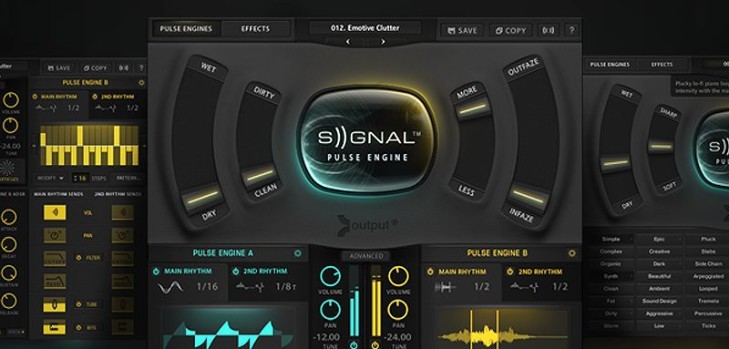After entering the scene last year with the groundbreaking REV virtual instrument, Output is back with yet another original creation for Native Instruments Kontakt. Their brand new sample based instrument called Signal has all of the qualities which are required to become a standard resource of rhythmic sequences and evolving sounds for aspiring electronic music producers, as well as film composers and sound designers.
Signal is based on a massive sound library with over 40 GB of high quality audio material, including samples of numerous analogue and digital synthesizers and real world organic instruments. The sample content is paired up with a performance oriented synthesis engine called the “pulse engine” which turns the static samples into thrilling pulsating sequences. The resulting sounds can be further shaped and transformed using an array of built-in effects and modulation sources.
The Review
The included samples are organized into two different categories – synthesized and organic sounds. The audio engineering team at Output has spent several months sampling all sorts of different synthesizers (both analogue and digital) and real world instruments, crafting a diverse collection of production ready multi-sampled audio material. The users can mix the sounds of sampled synthesizers and real word instruments together in order to create new and atypical sonic textures, or layer multiple sounds of the same type if they prefer a less avantgarde sonic palette.
See also: Free Reverse Loops By Output!
Although Signal is based on an impressive collection of multi-samples, its most spectacular component is the innovative “pulse engine” which is hidden behind one of the prettiest and most well-thought out custom user interfaces I’ve ever seen in a Kontakt instrument. Users who don’t necessarily enjoy the complexity of a modular synthesizer can easily transform the sounds to their liking using the four macro controls which are linked to different parameters in each preset instrument. On the other hand, more experienced sound designers and synthesis geeks will enjoy exploring the dazzling world of rhythmic possibilities which is right there waiting to be discovered by anyone who digs a bit deeper into Signal’s two pulse engine layers.
Each of the two pulse engine layers features a channel strip (providing easy access to common controls such as volume and pan) and two rhythm tabs. The rhythm tabs offer four different “pulse types”, or in other words four different ways to add movement and groove to the loaded samples – an LFO, a step sequencer, an arpeggiator and a tape loop style looper module which repeats a specific portion of the sample while a note is being held. The step sequencer and arpeggiator modules come with a large library of preset rhythms which can be used as-is or customized using the on-screen controls. Of course, it is also possible to build custom rhythmic sequences from scratch. The “Advanced” button (located between the two pulse engine layers) provides access to a panel of advanced controls for parameters like saturation and filtering, as well as volume and pitch envelopes. It is also possible to turn off the pulse engines completely in order to play back the samples in their original form.
In addition to the two pulse engine layers, the sounds can be further shaped with a wide selection of built-in effects which can be applied globally or individually to each of the two layers. Of course, the parameters of each effect module can be tweaked individually on a per-layer basis. Built-in effects include saturation, drive, stereo widening, delay, reverb, flutter, EQ, compression and lo-fi, whereas the the global FX module also includes a great sounding convolution reverb unit.
Finally, we get to the thing which makes Signal such a worthy addition to any film composer’s sound library and that is its preset library. The included instrument patches are utterly spectacular. Although Signal is a unique type of instrument specialized at creating rhythmic sequences, the library is quite resourceful and compatible with a wide range of music styles. In order to make browsing this diverse instrument library less of a time consuming task and more of a pleasurable experience, the creators have implemented a handy tagging system which makes it fairly easy to narrow down the list of available choices to a reasonable amount. Descriptive tags like “Aggressive”, “Epic”, or “Ambient” really help with finding the perfect preset for a certain task in just a few mouse clicks.
The Verdict
Signal is a thoughtfully crafted virtual instrument which does many things incredibly well. It is a tremendous resource of production-ready instrument presets for electronic music producers and film composers, as well as an awesome digital playground for sound designers who love experimenting with rhythmic patterns and pulsing sounds. The user interface is among the finest ones we’ve ever seen in a Kontakt instrument, being tremendously easy to use yet suitable for crafting the most complex and captivating rhythmic sequences.
More info: Output Signal ($199)
Output Signal Review
Signal has all of the qualities required to become a standard resource of rhythmic sequences and pulsing sounds for aspiring electronic music producers, as well as film composers and sound designers.
-
Features
-
Worfklow
-
Sound Quality
-
Design
-
Pricing


